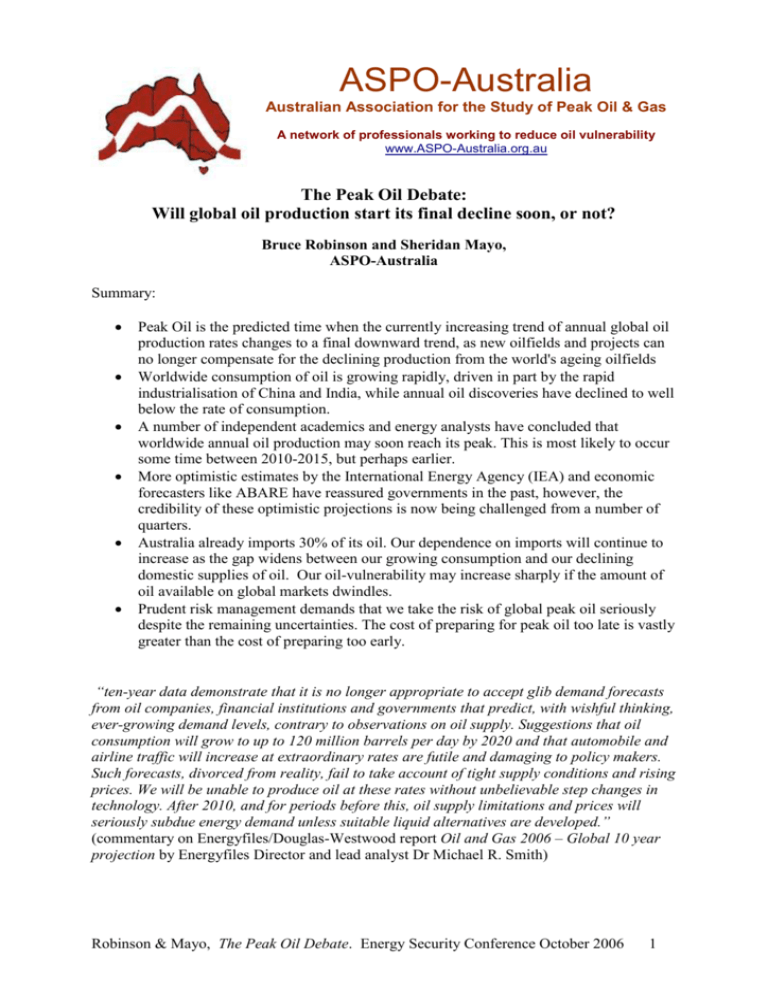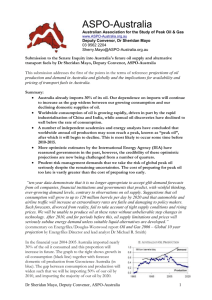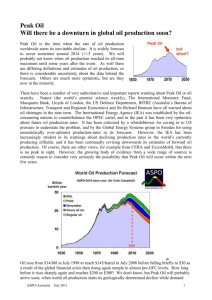The Peak Oil Debate: Will global oil production start its final decline
advertisement

ASPO-Australia Australian Association for the Study of Peak Oil & Gas A network of professionals working to reduce oil vulnerability www.ASPO-Australia.org.au The Peak Oil Debate: Will global oil production start its final decline soon, or not? Bruce Robinson and Sheridan Mayo, ASPO-Australia Summary: Peak Oil is the predicted time when the currently increasing trend of annual global oil production rates changes to a final downward trend, as new oilfields and projects can no longer compensate for the declining production from the world's ageing oilfields Worldwide consumption of oil is growing rapidly, driven in part by the rapid industrialisation of China and India, while annual oil discoveries have declined to well below the rate of consumption. A number of independent academics and energy analysts have concluded that worldwide annual oil production may soon reach its peak. This is most likely to occur some time between 2010-2015, but perhaps earlier. More optimistic estimates by the International Energy Agency (IEA) and economic forecasters like ABARE have reassured governments in the past, however, the credibility of these optimistic projections is now being challenged from a number of quarters. Australia already imports 30% of its oil. Our dependence on imports will continue to increase as the gap widens between our growing consumption and our declining domestic supplies of oil. Our oil-vulnerability may increase sharply if the amount of oil available on global markets dwindles. Prudent risk management demands that we take the risk of global peak oil seriously despite the remaining uncertainties. The cost of preparing for peak oil too late is vastly greater than the cost of preparing too early. “ten-year data demonstrate that it is no longer appropriate to accept glib demand forecasts from oil companies, financial institutions and governments that predict, with wishful thinking, ever-growing demand levels, contrary to observations on oil supply. Suggestions that oil consumption will grow to up to 120 million barrels per day by 2020 and that automobile and airline traffic will increase at extraordinary rates are futile and damaging to policy makers. Such forecasts, divorced from reality, fail to take account of tight supply conditions and rising prices. We will be unable to produce oil at these rates without unbelievable step changes in technology. After 2010, and for periods before this, oil supply limitations and prices will seriously subdue energy demand unless suitable liquid alternatives are developed.” (commentary on Energyfiles/Douglas-Westwood report Oil and Gas 2006 – Global 10 year projection by Energyfiles Director and lead analyst Dr Michael R. Smith) Robinson & Mayo, The Peak Oil Debate. Energy Security Conference October 2006 1 In the financial year 2004-2005 Australia imported nearly 30% of the oil it consumed and this proportion will increase in future. The graph to the right shows growth in oil consumption (black line) together with forecast 1.0 Million barrels/day Demand domestic oil production from 0.8 Geoscience Australia (in blue). The gap Australia between consumption and production 0.6 will widen. We will probably be 0.4 importing 50% of our oil by 2010, and importing the majority of our oil by 0.2 2020. Australia will therefore be Production 0.0 increasingly dependent on worldwide 1965 1985 2005 2025 oil supplies. The growth in worldwide oil consumption has accelerated in recent years due to the rapid industrialisation of China and India. This growth has eaten up the spare capacity in oil production traditionally maintained by the OPEC oil producers. In the past this spare capacity meant OPEC could open up the taps to meet surges in demand for oil, but now they are producing flat out and only Saudi Arabia claims to have some spare capacity remaining. This makes the world much more vulnerable to oil shocks and has led to high oil prices. When disaster or war disrupts oil production in one location it is much harder to make up that loss with increased production from elsewhere. While global oil consumption is growing, oil discoveries have been dwindling. Annual global oil discoveries peaked in the 1960s and have been in decline ever since (see figure left). Since the 1980s less oil has been found each year than has been consumed, and the gap between the two is growing. The world is no longer living on its oil “income” (i.e. discoveries) but is effectively consuming its oil “capital” in the form of reserves discovered decades ago. The consequence of this, as observed by Shell and Chevron amongst others, is that the age of cheap, easy-to-find oil is over, and that oil will be more difficult to find and extract, more costly and will increasingly consist of less desirable heavy, sour, and unconventional crudes. In individual oil producing regions the peak and decline of annual oil discoveries has been followed a number of years later by a peak and then decline in oil production. The USA’s oil discoveries peaked in the 1930s and production peaked in 1970, likewise the North Sea’s discoveries peaked in the 1970’s and production from this region peaked in 2000. Global oil production is expected to follow a similar pattern. A number of analysts have made global oil production forecasts based on worldwide oil production histories, reserves, and probable discoveries. Many such forecasts indicate the peak in global oil production will occur between 2006 and 2020. Below is a table showing the ranges of dates in which recent forecasters predict peak will occur, and a graph of forecast production from ASPO-International who predict that production will peak in about 2010. Robinson & Mayo, The Peak Oil Debate. Energy Security Conference October 2006 2 Peak year range now until 2010 2011-2015 2016-2020 2021+ Forecasters Deffeyes, Ivanhoe, ASPO, Bakhtiari, Skrebowski (ODAC) IEA(1998), Laherrère, Smith, Access Economics, Douglas-Westwood Consultants, JCF consultants, IEA (2004) (low resource case) Edwards, Bauquis IEA(2000), EIA, Shell, IEA (2004) (reference scenario) While there is a range of forecasts for the date of the global peak, there is growing consensus that the peak of oil production in non-OPEC countries will occur well before 2010-2015. The more optimistic projections for global supply (such as those of the IEA) therefore depend on the OPEC countries massively increasing production, not only to meet increasing demand, but also to offset declining oil production from outside OPEC. Many analysts are sceptical that OPEC can deliver, including senior figures within OPEC itself such as Sadad Al Husseini, a former vice-president of Saudi Aramco, who expects global oil production to reach its maximum by 2015. It is certain that existing OPEC plans to expand production come nowhere near meeting what the IEA say will be required. These observations lend credibility to forecasts of an earlier oil peak, and have led to critiques of over-optimistic forecasts by the IEA and USGS. A study for the US Dept of Energy by Robert Hirsch et al, (2005) showed that "initiating a mitigation crash program 20 years before peaking appears to offer the possibility of avoiding a world liquid fuels shortfall for the forecast period"and " without timely mitigation, the economic, social, and political costs will be unprecedented" If the more pessimistic forecasts are correct then we may well not even have this long to prepare. The consequences of reaching peak without mitigation measures in place include high and volatile oil prices impacting on business and the economy; fuel poverty among the poor; international tensions and competition over dwindling reserves; and actual fuel shortages. Prior policy-making and development based on the implicit assumption that fuel will continue to be cheap and plentiful will add to these problems by creating a legacy of land-use patterns and infrastructure ill-suited to a situation of fuel scarcity. WA's Minister for Planning and Infrastructure, Hon. Alannah MacTiernan, said in 2004 that “It is also certain that the cost of preparing too early is nowhere near the cost of not being ready on time.”. This crucial statement of fact has not yet been recognised for its importance and prescience. Robinson & Mayo, The Peak Oil Debate. Energy Security Conference October 2006 3 It is almost certain that Peak Oil will occur, and that it will arrive in the next decade or two. Many estimates cluster around the period 2010-2015, which must be regarded as the best available estimate at this time Despite the uncertainties about when Peak Oil will occur, prudent risk management demands that we look at the oil supply problems that are looming ahead and prepare well ahead of time. Oil vulnerability risk assessment and management are emerging areas to help organisations recognise and evaluate the problems and the opportunities that Peak Oil may bring. Background Reading: Australia's future oil supply and alternative transport fuels. Interim report, Australian Senate Rural and Regional Affairs and Transport References Committee, September 2006 http://www.aph.gov.au/senate/committee/rrat_ctte/oil_supply/index.htm Australia's future oil supply and alternative transport fuels. ASPO-Australia's submissions to the Senate inquiry into Australia's future oil supply from its many working groups are also available via www.ASPO-Australia.org.au. These include Finance Sector, Health Sector, Social Services Sector, Urban Transport and Planning, Biofuels and others Australia's future oil supply and alternative transport fuels. The submissions (192 plus) to the Senate are available on the Senate webpage. http://www.aph.gov.au/senate/committee/rrat_ctte/oil_supply/index.htm Oil depletion: the crucial factor in transport planning. Robinson and Powrie, Australasian Transport Research Forum, Adelaide, October 2004. This paper puts peak oil into an Australian context. ( http://www.aspo-australia.org.au//References/ATRF-57-Robinson-2-refs.pdf ) Peaking of World Oil Production: Impacts, Mitigation & Risk Management, Robert Hirsch et al, SAIC (for the US DoE) February 2005, http://www.netl.doe.gov/publications/others/pdf/Oil_Peaking_NETL.pdf The Peak and Decline of World Oil and Gas Production, K. Aleklett and C.J.Campbell, Minerals & Energy, 2003; 18:5-20, ( http://www.peakoil.net/Publications.html ) The Countdown for the Peak of Oil Production has Begun, W. Zittel, J. Schindler, L-BSystemtechnik, 12 October 2004, ( http://www.energiekrise.de/e/articles/LBST_Countdown_2004-10-12.pdf ) - critique of overly optimistic oil production forecasts by the IEA and USGS. Twilight in the Desert: The Coming Saudi Oil Shock and the World Economy by Matthew R. Simmons (Wiley 2005). Questions about Saudi oil reserve and future production claims. Megaprojects Report. Chris Skrebowski, Petroleum Review April 2006, 28-31 http://www.aspo-australia.org.au/References/Skrebowski/PR_APR06_Megaprojects.pdf Megaprojects Explained. Chris Skrebowski. background information about the method. http://www.aspo-australia.org.au/References/Skrebowski/Megaprojects-explained.doc Is the World Running Out of Oil: A review of the debate. Lyn Martin, BTRE Working Paper #61, May 2005 http://www.btre.gov.au/docs/workingpapers/wp61/wp61.aspx For further information, see www.ASPO-Australia.org.au or contact the authors at Bruce.Robinson@ASPO-Australia.org.au 61-8-9384-7409 Sherry.Mayo@ASPO-Australia.org.au 61-3-9562-2204 Robinson & Mayo, The Peak Oil Debate. Energy Security Conference October 2006 4




